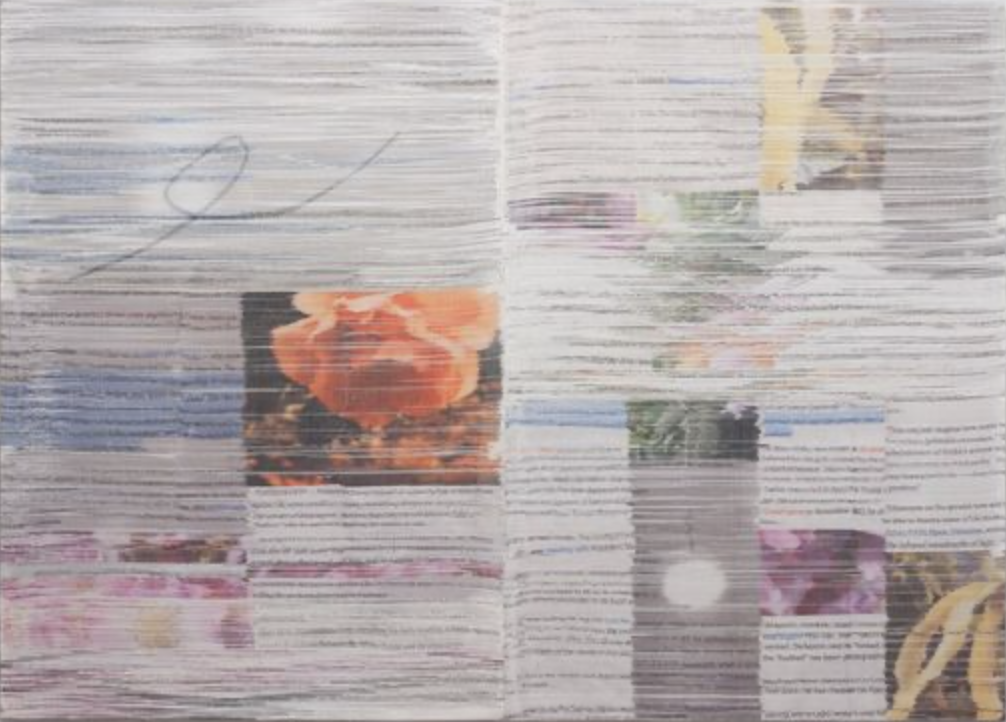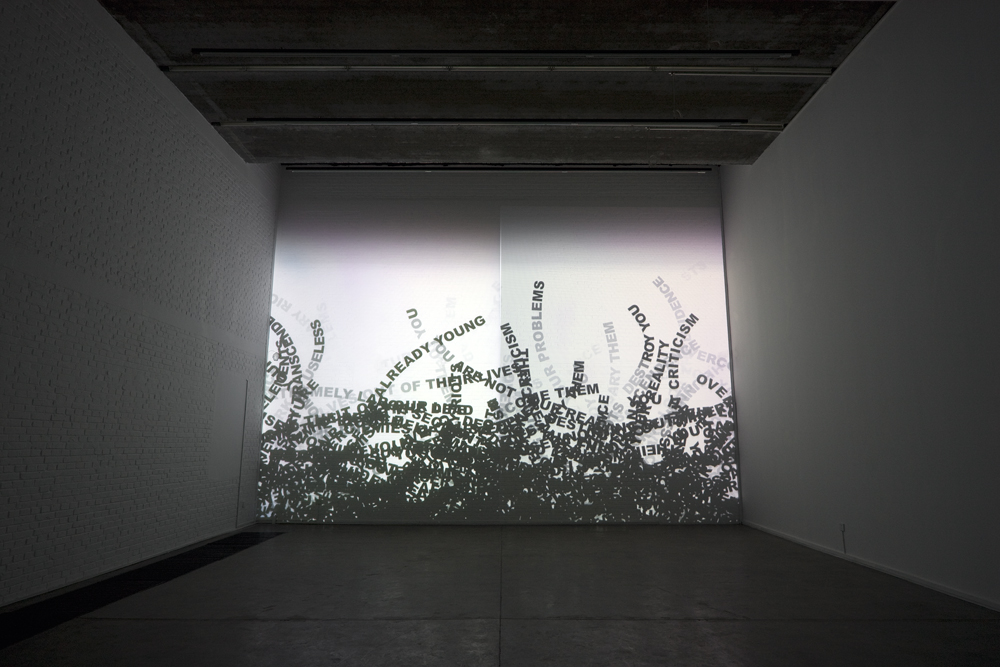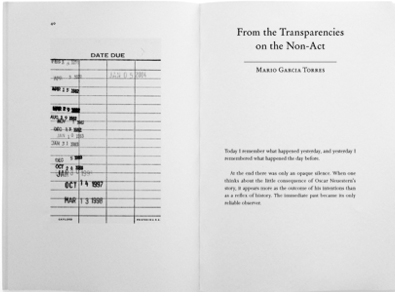
© » KADIST
Yangjiang Group
Drawing & Print (Drawing & Print)
One Day in the Mountain is a bilingual calligraphic performance piece written in ink superimposed with food leftover from a meal. The eponymous text: “One day in mountain is worth two thousands years in the world.” is written horizontally from left to right in both English and Chinese, following the writing order of modern Chinese instead of the traditional vertical right to left. With the word “is” migrating from the middle of the English phrase to be surrounded by Chinese characters, the resultant text appears to be spatially illustrating the meaning of being isolated in the mountain.

© » KADIST
Agatha Gothe-Snape
Agatha Gothe-Snape’s POWERPOINTS is an ongoing series of digital artworks that have been created with Microsoft PowerPoint. They are endless loops with sound. POWERPOINTS parallel Gothe-Snape’s broader conceptual practice stemming from improvisational performance.

© » KADIST
Hassan Massoudy
Drawing & Print (Drawing & Print)
Ranging from Baudelaire to the Koran, each of Hassan Massoudy’s drawings are titled with a quotation from a text. In the case of La beauté sauvera le monde, the text originated from Dostoyevsky’s The Idiot , alluding to aspirations, models of behavior and words of wisdom. The image itself, though generated in a hybrid manner relating to Arabic and Japanese calligraphy, suggests both fluttering flags and buildings rising high out of the desert as one would see in many developing Middle Eastern countries.

© » KADIST
Miguel Angel Rojas
Drawing & Print (Drawing & Print)
In his paper-based work, Medellin-New York , Rojas uses coca leaves and dollar bills to spell out the words of the two cities, tied together through the illicit exchange of materials used to make the word, gesturing towards the uncomfortable reality of the drug trafficking trade and the complicity of both America and Colombia within that economic system.

© » KADIST
Anthony Discenza
A Viewing (The Effect) by Anthony Discenza is a continuous voiceover loop intended for presentation in a dedicated, light-and-acoustically controlled space. “The Effect” employs hundreds of fragments of text culled from the internet by searching for occurrences of the title phrase. These fragments, which all address visual scenarios, were sequenced and edited to create the impression of a single text; this was recorded as a voiceover and presented in an acoustically controlled space devoid of any visual information.

© » KADIST
Margo Wolowiec
Imagine How Many by Margo Wolowiec is a woven polyester depiction of blurred text and floral images found on social media, distorted beyond complete recognition. It resembles a newspaper with a conspicuous “fold” down the middle, but its contents are undoubtedly drawn from Wolowiec’s practice of image aggregation and do not follow the clear formatting newspapers normally possess. Instead, Wolowiec has created an alternative publication of sorts, drawing in a third, comparative source of “networked” imagery and information, inserting the concept of publication and social media into her greater examination of the structures governing dissemination.

© » KADIST
Pablo Accinelli
In Onde quer que voce esteja (2011) Accinelli sets up a row of cardboard shipping tubes of varying heights and inscribes on them in black ink the words of the title, which translates in English as “Wherever you may be.” The words, while legible, seem like fragmented lines and shapes—almost but not quite a deconstruction of the text. Accinelli explores the relationship between objects as metaphors of their own materiality and as tools for conveying ideas.

© » KADIST
Bjorn Copeland
Sign #1 , Sign #2 , Sign #3 were included in “Found Object Assembly”, Copeland’s 2009 solo show at Jack Hanley Gallery, San Francisco. These rather austere collages were created by simply cutting and inverting the text from existing information signs. In Sign #2 , for example, the original image that presumably carried the message “NO RIDERS” was placed upside down.

© » KADIST
Mario Garcia Torres
Mario Garcia Torres imagines cinematic devices to replay stories occasionally forgotten by Conceptual art. For him, this is a way of rethinking the tradition in a more personal way, to have a grip on events of recent history and examine them with a curiosity, both critical and sensual. The artist emphasizes the fact that new ideas and meanings may arise from these archaeological narratives.

© » KADIST
Xiaoyun Chen
The central point of Vanishing Point is the most direct physiological reaction of the body to the environment. Chen Xiaoyun has added a written narrative and a poetic quality to his works. Image fragments containing different pieces of information are linked together by the text, their interplay producing a synesthesia effect.

© » KADIST
Natasha Wheat
Wheat’s work is built on a strong conceptual framework that weaves together commentary on social and political issues and the radical potential for change. Be Oblivion, in Disconnect (2011) is a sculpture and an intervention. Two cardboard boxes house white neon letters that collectively have the potential to spell “Be Oblivion.” The dismembered phrase is rendered powerless in its present state; the potential power lies with the viewer, who could conceivably reconstruct it.

© » KADIST
Bernardo Ortiz
Drawing & Print (Drawing & Print)
Casa de la cabeza (2011) is a drawing of the words of the title, which translate literally into English as “house of the head.” Ortiz uses this humorous phrase to engage the idea of living in your head.

© » KADIST
Johanna Calle
Drawing & Print (Drawing & Print)
Calle’s drawings all inhabit received forms but alter them to call attention to specific qualities. A newspaper is both reproduced and modified to call attention to the newspaper as a means of information transmission. This also emphasizes the effect of various seemingly unimportant support mechanisms: the role of visual layout and images.

© » KADIST
Tsang Kin-Wah
The Third Seal—They Are Already Old. They Don’t Need To Exist Anymore is part of The Seven Seals , Tsang’s ongoing series of digital videos that are projected as installations onto the walls and ceilings of dark rooms. Using texts and computer technology, the series draws its reference from various sources—the Bible, Judeo-Christian eschatology, existentialism, metaphysics, politics, among others—to articulate the world’s complexity and the dilemmas that people face while approaching “the end of the world.” The Third Seal is a nineteen-by-twenty-seven-foot projection on a single wall that, together with sound, creates an immersive and dynamic environment.

© » KADIST
Alicia McCarthy
Drawing & Print (Drawing & Print)
A painting reminiscent of a certain “naive primitivism,” Untitled (the way in is the way out) is representative of McCarthy’s work. Upon first encounter, her abstract colorful compositions resemble somewhat formal nonrepresentational landscapes. However, a closer inspection reveals the presence of a lowbrow style that draws inspiration both from outsider and folk art traditions.

© » KADIST
John Baldessari
In One Must , an image of a pair of scissors, accompanied by the words of work’s title, poses an ominous question about the relationship between the image and the text. The otherwise banal scissors become suggestively violent in relation to the text, which was originally the title of a print in Francisco de Goya’s Disasters of War series. However, Baldessari is less interested in the logical relationships between text and image than he is with the conceptual leaps that the viewer makes with the limited information provided.
Margo Wolowiec
Margo Wolowiec uses her multidisciplinary practice to examine space, material versus conceptual practices, and affective responses...
Pablo Accinelli
- year born: 1983
- gender: male
- nationality: Argentinian
Tsang Kin-Wah
- location: Hong Kong, China
- year born: 1976
- gender: male
- nationality: Chinese
- home town: Shantou, Guangdong Province, China
Alicia McCarthy
- location: Oakland, California
- year born: 1969
- gender: female
- nationality: American
- home town: Oakland, California
Hassan Massoudy
Hassan Massoudy trained as a classical calligrapher in Baghdad before attending the Ecole des Beaux-Arts in Paris in 1969...
Yangjiang Group
Zheng Guogu founded the artistic group Yangjiang Group in 2002 with Chen Zaiyan (b...
Bernardo Ortiz
- location: Bogota, Colombia
- year born: 1972
- gender: male
- nationality: Colombian
- home town: Bogota, Colombia
Anthony Discenza
Since the late 1990s Anthony Discenza’s work has focused primarily on the omnipresence of mainstream media...
Miguel Angel Rojas
For Colombian artist Miguel Ángel Rojas, issues of economic and social inequality in his native country provide fodder to his artistic practice...
John Baldessari
- location: Los Angeles, California
- year born: 1931
- gender: male
- nationality: American
- home town: National City, California
Mario Garcia Torres
- location: Mexico City, Mexico
- year born: 1975
- gender: male
- nationality: Mexican
- home town: Monclova, Mexico
Bjorn Copeland
- location: New York, New York
- gender: male
Johanna Calle
- location: Bogota, Colombia
- year born: 1965
- nationality: Colombian
- home town: Bogota, Colombia
Agatha Gothe-Snape
Based in improvisational performance, the meeting point between artistic process and social context is a central theme in Agatha Gothe-Snape’s work...
Xiaoyun Chen
- location: Hangzhou, China
- year born: 1971
- gender: male
- nationality: Chinese
- home town: Hubei Province, China
-
1990-1999
John Baldessari
1997In One Must , an image of a pair of scissors, accompanied by the words of work’s title, poses an ominous question about the relationship between the image and the text...
-
2000-2009
Johanna Calle
Drawing & Print
2003(Drawing & Print) Calle’s drawings all inhabit received forms but alter them to call attention to specific qualities...
Mario Garcia Torres
2004Mario Garcia Torres imagines cinematic devices to replay stories occasionally forgotten by Conceptual art...
Agatha Gothe-Snape
2008Agatha Gothe-Snape’s POWERPOINTS is an ongoing series of digital artworks that have been created with Microsoft PowerPoint...
Hassan Massoudy
Drawing & Print
2008(Drawing & Print) Ranging from Baudelaire to the Koran, each of Hassan Massoudy’s drawings are titled with a quotation from a text...
Bjorn Copeland
2009Sign #1 , Sign #2 , Sign #3 were included in “Found Object Assembly”, Copeland’s 2009 solo show at Jack Hanley Gallery, San Francisco...
-
2010-2019
Anthony Discenza
2010A Viewing (The Effect) by Anthony Discenza is a continuous voiceover loop intended for presentation in a dedicated, light-and-acoustically controlled space...
Alicia McCarthy
Drawing & Print
2010(Drawing & Print) A painting reminiscent of a certain “naive primitivism,” Untitled (the way in is the way out) is representative of McCarthy’s work...
Miguel Angel Rojas
Drawing & Print
2011(Drawing & Print) In his paper-based work, Medellin-New York , Rojas uses coca leaves and dollar bills to spell out the words of the two cities, tied together through the illicit exchange of materials used to make the word, gesturing towards the uncomfortable reality of the drug trafficking trade and the complicity of both America and Colombia within that economic system....
Pablo Accinelli
2011In Onde quer que voce esteja (2011) Accinelli sets up a row of cardboard shipping tubes of varying heights and inscribes on them in black ink the words of the title, which translates in English as “Wherever you may be.” The words, while legible, seem like fragmented lines and shapes—almost but not quite a deconstruction of the text...
Natasha Wheat
2011Wheat’s work is built on a strong conceptual framework that weaves together commentary on social and political issues and the radical potential for change...
Bernardo Ortiz
Drawing & Print
2011(Drawing & Print) Casa de la cabeza (2011) is a drawing of the words of the title, which translate literally into English as “house of the head.” Ortiz uses this humorous phrase to engage the idea of living in your head....
Yangjiang Group
Drawing & Print
2012(Drawing & Print) One Day in the Mountain is a bilingual calligraphic performance piece written in ink superimposed with food leftover from a meal...
Xiaoyun Chen
2014The central point of Vanishing Point is the most direct physiological reaction of the body to the environment...
Margo Wolowiec
2017Imagine How Many by Margo Wolowiec is a woven polyester depiction of blurred text and floral images found on social media, distorted beyond complete recognition...






